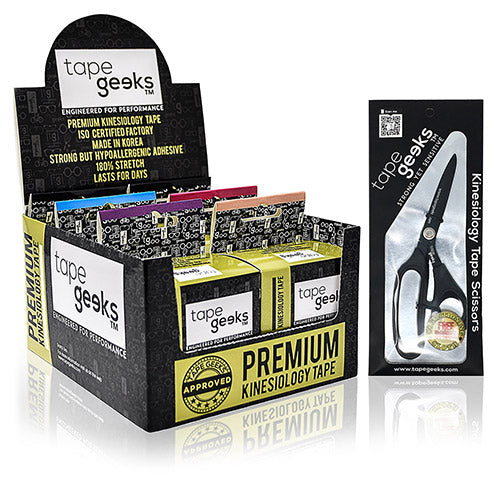
As one of the most popular pursuits for each new year, fitness goals are shrugged off continuously by most folks to be nothing but a pipe dream. The statistics are not too optimistic, either. Less than 25% of people stay committed to the goals they have set for themselves.

Shop our bundles now
Shop NowHowever, if you're one of the brave souls who are looking to beat the odds, then you have to hear us out on what Kinesiology taping can do for you. Discover how to tape sport-related injuries for different areas of the body and receive support. Tape on as you journey on to a fitter and healthier you!
Table of Contents:
What is kinesiology tape?
With its recent rise in popularity, chances are you've seen these vivid and brightly colored tapes plastered all over the shoulders, abs, knees of famous athletes or trainers.

Created by Dr. Kenzo Kase in the 1970s, Kinesiology tapes deliver muscle support and prevent injuries without limiting your range of motion. They’re also widely used to alleviate swelling and for pain relief in different areas of the body.
How can kinesiology tape help your workouts?
Feeling that “good pain” is all part of the process when working out. No pain, no gain, as they say. And, just as pain is all part of the process of staying active, injuries are an inevitable part of it also.
Kinesiology taping can help support those injured body parts, boost recovery, even for injury prevention, and enhance performance.

Kinesiology tape is used by physical therapists, professional athletes, trainers, and a slew of active folks for different injuries. These include plantar fasciitis, ankle sprains, shin splints, and several other injuries. What kin tape essentially does is to lift the skin from the muscle below.
The tape's "lifting action" reduces swelling while promoting blood flow to increase muscle functionality.
If you want a more in-depth discussion on the benefits of kin tapes, you can check our article here.
How to use kinesiology tape for knee pain
Most common among runners, basketball players, volleyball players, here’s how to tape for knee pain:
- Ensure your knee is bent at a 90-degree angle. Apply the compression strip to the area of pain at a 50% stretch.
- Get another strip. Apply from the top of the shin to the bottom of the thigh with no stretch.
- Perform step 2 from the opposite side with no stretch.
You can also watch this video tutorial on how to use kinesiology tape for your knee instead.

Shop our kinesiology tape now
Shop NowHow to use kinesiology tape for shoulder pain
A common injury among baseballers, softballers, swimmers, and volleyball players, here’s how you can tape for general shoulder pain:
- Measure the compression strip. Then, apply to the area of discomfort at a 30-50% stretch.
- Apply a second piece with 0% stretch.
- Apply the final strip on the back of the deltoid. Start at top of your bicep with 0% stretch.

Here's a video presentation on how to use kinesiology tape for your shoulder pain.
How to use kinesiology tape for elbow pain or tennis elbow
Also called tennis elbow, here’s how you can tape for elbow pain:
- Ensure the wrist is bent downwards to stretch the forearm muscle.
- Apply the strip to the area of discomfort at 50% stretch.
- Anchor the strip on the inside of the wrist, spiraling it once to the top of the elbow.

You can watch this video demonstration on how to use kinesiology tape for elbow pain.
How to use kinesiology tape for an ankle sprain
Common among sports that involve quick direction changes, ankle sprains are usually experienced by footballers, soccer players, basketball players. Here’s how to tape for ankle sprains:
- Start with the compression strip on the painful part of your ankle.
- Anchor the stabilization strip on the top of the foot to travel along the entire outside of the lower leg.

Here's a video tutorial on how to use kinesiology tape for an ankle sprain that you can follow.
How to use kinesiology tape for neck pain or trapezius pain

Not necessarily a common complaint among athletes, neck pain is a common enough occurrence for folks that might be due to stress, work, or even just day-to-day tasks. Here’s how to tape for trapezius pain:
- Apply a compression strip to the painful part of the muscle with 50% tension.
- Apply a stabilization strip across the area of the greatest discomfort with no stretch.
Here's a video tutorial that you can follow on how to use kinesiology tape for neck pain.

Shop our collection now
Shop NowSubscribe to the TapeGeeks Newsletter for new videos, discounts and more!Join The Geeks Club









